Friday, February 10
Saturday, February 11
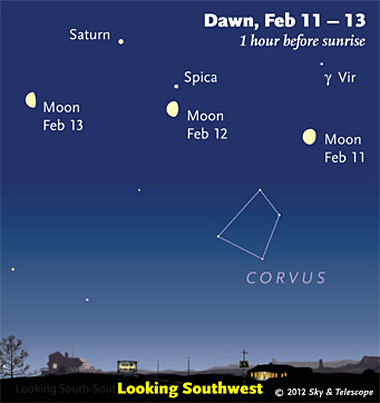
By the time dawn begins to brighten, Saturn, Spica, and the waning Moon passing them are high in the southwest. (Moon positions are exact for the middle of North America. For clarity, the Moon is shown three times its actual apparent size.)
Sky & Telescope diagram
By dawn Sunday morning they've all moved over to the southwest and twisted around, as shown at right.
Sunday, February 12
Monday, February 13
Tuesday, February 14
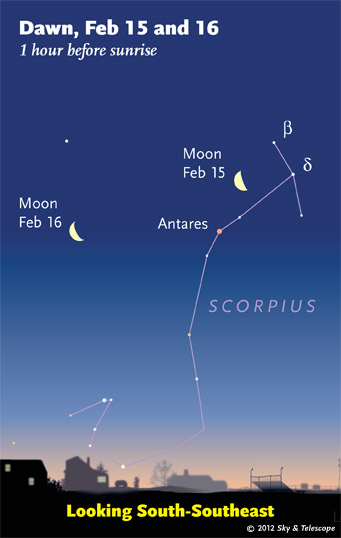
By the 15th and 16th, the dawn Moon has thinned and moved eastward to pass Scorpius.
Sky & Telescope diagram
Wednesday, February 15
When to look? Canopus transits when Beta Canis Majoris (Mirzim) does. That's the fairly bright star about three finger-widths at arm's length to the right of Sirius. Look straight down from there.
Thursday, February 16
Friday, February 17
Saturday, February 18
Want to become a better amateur astronomer? Learn your way around the constellations. They're the key to locating everything fainter and deeper to hunt with binoculars or a telescope.
For an easy-to-use constellation guide covering the whole evening sky, use the big monthly map in the center of each issue of Sky & Telescope, the essential magazine of astronomy. Or download our free Getting Started in Astronomy booklet (which only has bimonthly maps).

The Pocket Sky Atlas plots 30,796 stars to magnitude 7.6 — which may sound like a lot, but that's less than one star in an entire telescopic field of view, on average. By comparison, Sky Atlas 2000.0 plots 81,312 stars to magnitude 8.5, typically one or two stars per telescopic field. Both atlases include many hundreds of deep-sky targets — galaxies, star clusters, and nebulae — to hunt among the stars.
Sky & Telescope
Once you get a telescope, to put it to good use you'll need a detailed, large-scale sky atlas (set of charts). The standards are the little Pocket Sky Atlas, which shows stars to magnitude 7.6; the larger and deeper Sky Atlas 2000.0 (stars to magnitude 8.5); and the even larger Uranometria 2000.0 (stars to magnitude 9.75). And read how to use sky charts effectively.
You'll also want a good deep-sky guidebook, such as Sue French's new Deep-Sky Wonders collection (which includes its own charts), Sky Atlas 2000.0 Companion by Strong and Sinnott, the bigger Night Sky Observer's Guide by Kepple and Sanner, or the classic if dated Burnham's Celestial Handbook.
Can a computerized telescope replace charts? I don't think so — not for beginners, anyway, and especially not on mounts that are less than top-quality mechanically. As Terence Dickinson and Alan Dyer say in their Backyard Astronomer's Guide, "A full appreciation of the universe cannot come without developing the skills to find things in the sky and understanding how the sky works. This knowledge comes only by spending time under the stars with star maps in hand."
This Week's Planet Roundup
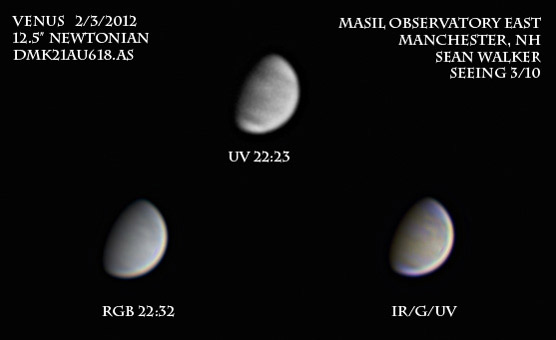
Venus is almost always a totally featureless blank white to visual observers. But digital stacked-video imaging can sometimes bring out the planet's subtle cloud patterns. These are especially visible in the near ultraviolet (UV). S&T's Sean Walker took these images through color filters on the evening of February 3rd, using the same equipment described for Mars below.
S&T: Sean Walker
.
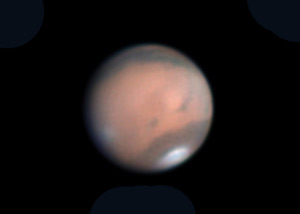
Mars had grown to 12.2 arcseconds wide by February 5th, when S&T's Sean Walker took this image with a 12.5-inch Newtonian reflector and a DMK 21AU618.AS video camera. South is up. The North Polar Cap is the most obvious feature, but it's already shrinking in the of the Martian northern-hemisphere spring. The subtle bright area just right of center is Elysium, next to dark Hyblaeus. Note the cloud at Olympus Mons on the sunset terminator (at left; celestial west), and the faint cloud haze along the morning limb (right; celestial east).
S&T: Sean Walker
Mercury is buried deep in the glow of sunset. But wait just another couple of weeks, and Mercury will be having its best evening apparition of the year!
Venus (magnitude –4.2, in Pisces) is the brilliant “Evening Star” shining in the southwest during and after dusk. (Don't confuse it with Jupiter higher to its upper left.) Venus doesn't set now until two hours after dark. It will continue to move a bit higher, stay up later, and brighten slightly for the rest of the winter. In a telescope Venus is a brilliant white gibbous disk 16 or 17 arcseconds in diameter and 70% sunlit. It will reach half-lit phase (dichotomy) in mid- to late March.
Mars (about magnitude –0.9, in western Leo) rises bright fire-orange in the east soon after dark. It's far beneath the Sickle of Leo and to the right of 2nd-magnitude Denebola, Leo's tail star. Mars continues to brighten as it approaches Earth. It shines highest in the south, in best telescopic view, around 2 a.m.
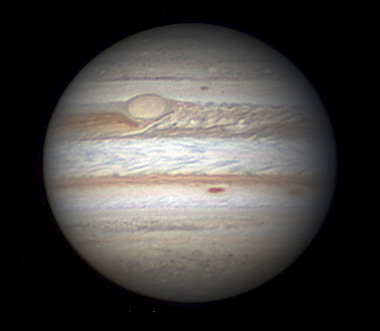
Jupiter is shrinking as Earth leaves it farther behind, but Christopher Go in the Philippines caught some excellent seeing on January 29th for this extraordinary shot of developments around the Great Red Spot. South is up. Note the white turbulence on the following (right; celestial east) side, and the stark red part of the South Equatorial Belt on the spot's preceding side.The red transitions to white as it squeezes past the spot.
In a telescope Mars has grown to about 13.0 arcseconds wide, practically at the 13.9″ it will display when it's nearest to Earth in early March. Mars appears only very slightly gibbous now — 98% sunlit — since it is getting close to opposition (which happens March 3rd).
Jupiter (magnitude –2.3, still at the Aries-Pisces border) shines high in the southwest at dusk, high to the upper left of brighter Venus. The gap between Jupiter and Venus is narrowing by 1° per day: from 30° to 23° this week. They're on their way to a spectacular conjunction just 3° apart on March 13th.
Jupiter moves lower toward the southwest as evening advances, then sets in the west around 11 or midnight. In a telescope Jupiter has shrunk to 38 or 37 arcseconds wide, as Earth pulls ahead of it in our faster orbit around the Sun.
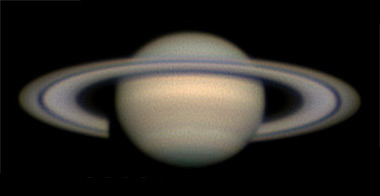
Saturn's rings are tipped a good 15° from our line of sight. South is up. Note the very pale light band in the north temperate region, apparently the remnant of the dramatic, billowing white outbreak that attracted so much attention last year. Christopher Go took this image on January 21, 2012.
Saturn (magnitude +0.5, in Virgo) rises in the east around 11 and is shines highest in the south an hour before dawn. Spica, a little fainter at magnitude +1.0, is 7° to Saturn's right or upper right. Saturn's rings are tilted a generous 15° from our line of sight, the most open the rings have appeared since 2007. Saturn comes to opposition in mid-April.
Uranus (magnitude 5.9, in Pisces) is in the background of Venus in the early evening sky. It was just 0.3° south (lower left) of Venus on February 9th; now it moves about 1° farther to Venus's lower right each evening.
Neptune is hidden behind the glare of the Sun.
All descriptions that relate to your horizon — including the words up, down, right, and left — are written for the world's mid-northern latitudes. Descriptions that also depend on longitude (mainly Moon positions) are for North America. Eastern Standard Time (EST) equals Universal Time (also known as UT, UTC, or GMT) minus 5 hours.
Like This Week's Sky at a Glance? Watch our new weekly SkyWeek TV short. It's also playing on PBS!
To be sure to get the current Sky at a Glance, bookmark this URL:
http://SkyandTelescope.com/observing/ataglance?1=1
If pictures fail to load, refresh the page. If they still fail to load, change the 1 at the end of the URL to any other character and try again.
 0
0
Comments
You must be logged in to post a comment.